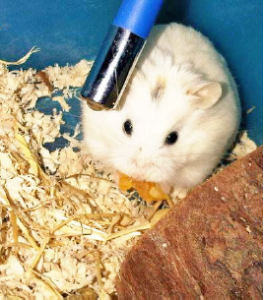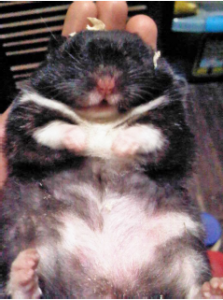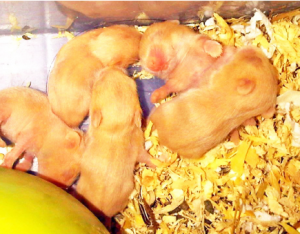Learn more about caring for these popular little pets.

Hamsters: what small animal fancier doesn’t love these little guys? Animal Scene featured the popular Syrian hamster in our March 2016 issue; in this issue, we sat down with Caezar Vizcarra, who’s kept hamsters for nearly two decades and who pioneered the first hamster group in the Philippines, CHOP (Circle of Hamster Owners of the Philippines); from there, several groups followed suit.
Caezar now focuses on sharing his knowledge and experience in caring for hamsters properly, and here, he talks about hamster breeds and what he’s learned from his extensive experience in caring for them. You may find that his advice may differ from that given by others in previous issues of the magazine.

That isn’t meant to confuse; rather, we at Animal Scene believe in giving readers the viewpoints of different experts so that you can read these and make your own care decisions based on your research and experience.
Q: It was previously stated by another interviewee in Animal Scene that hamsters make ideal pets for children, but you disagree with this. Can you expound on why hamsters do not make good pets for children who are 6 years old and below?
A: Contrary to the belief that hamsters are pets for kids, we actually suggest them for ages 6 and above as hamsters have fragile bodies, and younger children may squish them, causing them to bite; worse, kids can sometimes crush a hamster’s small body to death.
Q: Who, in your opinion, is the ideal hamster owner? What is the ideal habitat for a hamster?
A: Ideally, I believe that hamsters are for kids 12 and above as they have a stronger sense of responsibility and are more likely to be open to learning more about how to care for their pet.
For its habitat, it is suggested to have a total floor area of 24 x 12 inches for a single hamster; ample bedding material for burrowing and digging; proper ventilation; and areas to eat, drink, sleep, play, and go potty. The reason for this is that hamsters need plenty of exercise and running space as they roam freely in open areas in the wild. The rule of thumb in having hamster habitats is: the bigger, the better.
Q: Which breeds are the most popular in the country, and why?
A: The most popular breed in the Philippines is still the Syrian hamster. It is also referred to as the Golden or Teddy Bear hamster. It’s quite popular because of its calm temperament and how it’s easily tamable. The next most popular breed is the Campbell’s Dwarf hamster, which is mistakenly identified here as “Siberian hamsters.” (Siberian hamsters are a different species.) The Campbell’s Dwarf hamster is known to be quite temperamental and nippy, but being in the dwarf genus, they are quite adorable.

Teddy Bear or Golden hamster, is the
most popular breed kept as pets.
Q: You mentioned that Syrian hamsters are the hardiest of their kind. Can you shed some light on hamster health and toughness for our readers?
A: This is probably due to the fact that they have been kept as pets for the longest time, compared to the other breeds. They are able to somewhat adjust to living with humans. Though generally, hamsters are very sensitive to extreme heat. Health-wise, they are known to be generally of good health but they are prone to cancers, diabetes, and even genetic disorders, especially when not cared for properly.
Q: Can you share with us the new hamster breeds you have, and what makes them special?

A: I currently keep only two breeds: the Chinese Dwarf hamster and the Roborovski Dwarf hamster. The Chinese Dwarf hamster is very “mousy” in appearance and they are very adept climbers. They also have slender bodies and a tail that measures 1 inch that they use for balancing themselves when climbing. They are also sometimes known as “pocket hamsters” as you can carry them around at home in your front shirt pocket. The Roborovski Dwarf hamster, on the other hand, is known to be the fastest and smallest hamster to date. They have round, stubby bodies and have distinct white patches above their eyes that resemble eyebrows.
Q: What are the misconceptions and myths about hamsters that you feel are most dangerous to the animal?

A: That they can be kept in small cages; they need plenty of space to run, roam, eat, sleep, drink, go potty, dig, and play. That Syrians can be kept by pairs; they should be kept alone as they are solitary animals. Keeping more than one in a cage results in fighting. That they can be bred extensively; they are prone to cannibalize or abandon their young when threatened, stressed, or nutritionally deficient.
Q: Many good keepers and breeders frown on the practice of some indiscriminate pet shops of breeding hamsters as young as two months old. Can you expound on this (and the dangers of repeatedly breeding close relatives)?

A: Breeding them at a young age creates problems, especially for the mother, as she is not mature enough to handle and care for the pups. This often results in abandoned or cannibalized pups. Meanwhile, breeding related hamsters creates problems in the genetic aspect, which in turn spawns abnormal hamsters that have neurological disorders, deformities, and temperament issues.
Q: What, for you, are the best qualities of hamsters as pets?
A: They are relatively easy to care for, require less space (compared to cats and dogs), can be very friendly and tame, and have endless habitat possibilities.
Q: You mentioned that ideally, some hamster breeds are the “look, don’t touch” type, but others insist that hamsters always make good pets. Can you explain this seeming paradox for our readers?

A: Well, I would say that this mainly applies to children who do not understand yet how to care for them, especially those that need taming and proper handling. Kids might squish them, resulting in the hamster biting or worse, it can be squished to death.
What I would suggest is that parents also partake in the introduction of hamsters, and I advise that hamsters should not be given as pets to kids 6 years and below. Should a child really want to pursue the hobby, have them watched but minimize the handling—do this only when the parents are around. But once a habitat has been set up for them, hamsters make really amazing pets as you can watch them in action.

Q: What direction would you like to see hamsters and the hobby in general take in the country over the next few years?
A: I see the hobby flourishing in a better light. I am actually quite surprised with the impact I made on other hobbyists, considering that I am young. I also am hoping that the hobby focuses not on breeding, selling, and quantity but on the quality and improvement of the hamsters’ living conditions.
Photos and all responses by Caezar Vizcarra
This appeared as “Hamster Helper: Learn More About Caring for These Popular Little Pets” in Animal Scene’s June 2016 issue.






